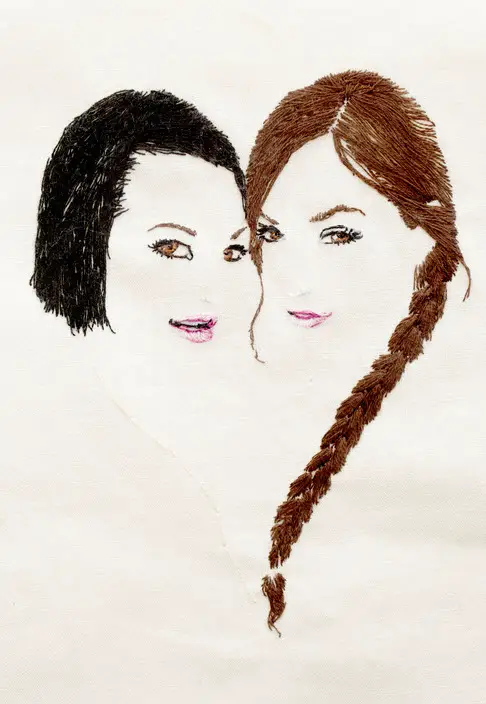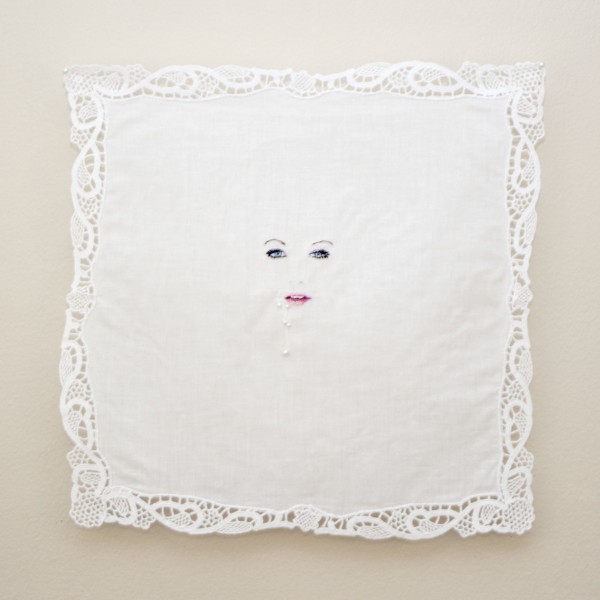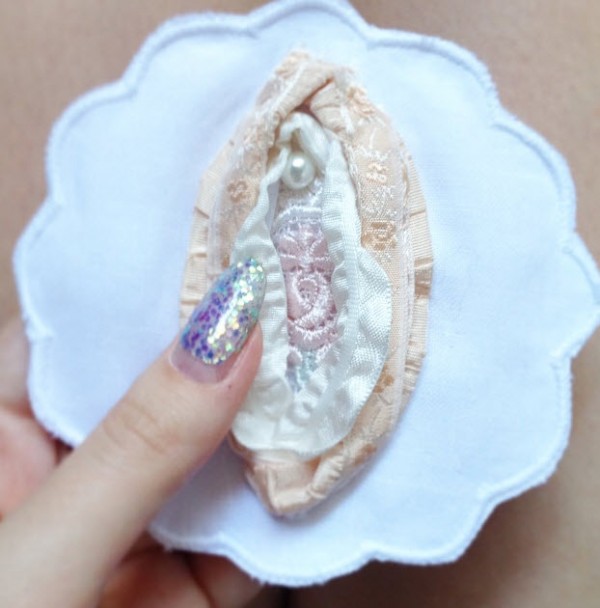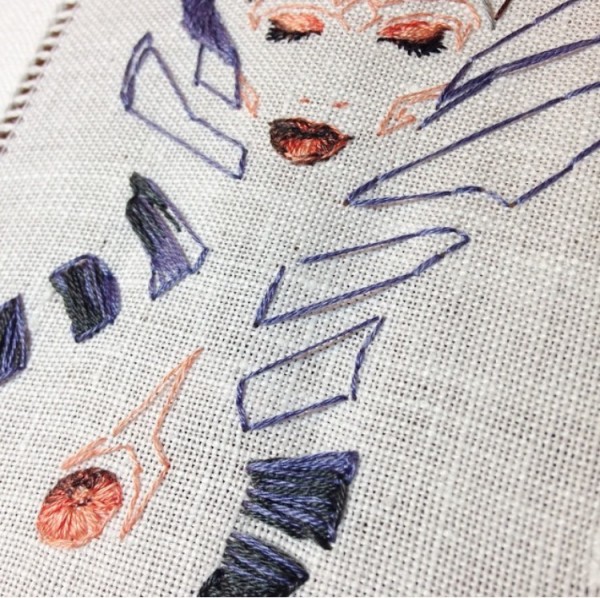(Warning: The artwork featured in this column is Not Safe For Work by many standards, so be selective about when you view it. But do not miss it.)
When writing about the hyper-feminine, delicate artwork of Emma Rose Laughlin, the tag line could read, “This is not a pearl.”
Why? Because lace, pearls and buttons are often stand-ins for labia, semen and clitorises.
In Laughlin’s work, delicacy and femininity, long associated (in Western embroidery, at least) with needle arts, become both the language and tools of her unabashed exploration of eroticism, sexuality and female strength.
Laughlin does not shy from creating on the boundary and challenging the viewer’s assumptions about what comprises female strength. She understands that not everyone will agree that her portraits of porn stars are empowering and not objectifying depictions of women. But she welcomes that conversation.
The Toronto-born, California-raised artist studied drawing and painting at OCAD University in Toronto. She came to embroidery in her thesis year, she says. “When I began to pursue more erotic subject matter I found painting to be somewhat constricting. I didn’t want the shock value that would come from a huge oil painting so I tried to make most of my paintings very small. It was through the intimate process of leaning over a teeny tiny painting that I discovered I was very detail-oriented, and that eventually led to the interest in embroidering.”
“The medium suited me greatly because of its delicacy and femininity and I already loved making such small-scale work,” she says.
What follows is an interview that took place in July and August of 2015.
*****
Olisa Corcoran: I love how you describe creating your pieces with thread as working with a line, “just like a line made by a pencil or a brush, and it’s just a matter of being able to manipulate it into doing what you want (even though the line one makes with a pencil is never at risk of getting tangled and knotted unexpectedly).” How do you make the make the jump from lines on paper or a screen to stitches on cloth? Do you keep a sketchbook, take photographs or clip files of the world around you?
Emma Rose Laughlin: When stitching portraits, my process usually begins with a printed reference photo. I pin the printed image to my stretched fabric, make some small preliminary stitches to indicate important landmarks in the face (distance between the eyes, width of the mouth, etc.), and rip the paper off. At this point I’m able to render the features without worrying about placement. It would be a nightmare to spend a day and a half on a perfectly rendered eye only to find out later it needs to be an eighth of an inch lower. I never do preliminary sketches for my embroideries; I personally find it’s too redundant since the stitching process is so similar to drawing already. If I’m ever taking a break from stitching I like to do watercolor sketches. Watercolor is so fluid and disorderly; it’s a nice change of pace sometimes.
Your embroideries of female faces focus strongly on the eyes and the mouths of your subjects. What attracts you to that particular kind of imagery of female faces?
The imagery I work with stems from my need to portray sexually empowered women in a positive light. I embrace the idea that women can be sweet, loving and nurturing creatures while also being sexually assertive. Embroidery is such an intrinsically feminine medium, and by using it to render these graphic sexual acts I’m able to make them more delicate and approachable. Looking at an embroidered doily triggers so many feminine associations. For example, the white lace might remind the viewer of their grandmother’s dinner linens or a wedding dress or lacy lingerie. The pearl embellishments might remind the viewer of women’s jewelry. I want my artwork to encourage all of these associations while harmonizing them with carnal female sexuality, which in my opinion is a very important aspect of femininity. The eyes and mouth are the most important details of my portraits, which often leads me to avoid rendering anything else entirely. I love to work reductively. I think it may have something to do with my eagerness to create a conversation with the viewer, so I only provide them with the bare minimum visually, so to speak. It requires the viewer to take a closer, more detailed look at the pieces, at everything from the medium of embroidery to the subject matter itself.
When embroidering porn star portraits I always aim to depict a very engaged look, both seductive and confident. To me these women are embracing their sexuality, and I want that power to read in their eyes. I also love how putting all of the focus on the eyes and mouth in these portraits mimics the way women purposefully draw attention to their eyes and mouth when putting on makeup.
The fact that they’re covered in cum is almost too subtle to notice at first. The white beads on the white background are usually the last thing viewers become aware of. This subtlety is important to me since I want the erotic nature of the portrait to exist within a delicate, approachable context.
Your Blossoms are lovely — incredibly layered and delicate. I particularly enjoy the way you use of materials strongly associated with femininity from a bygone era (lace, pearls and buttons) to build public, 21st Century representations of an intimate, often hidden part of the female body. Can you tell us about the development of that project?
Thank you! This idea was initially inspired by materials. A few years ago I tried making my own lingerie and ended up failing miserably, which left me with an abundance of ribbons and lace and other embellishments. Then last year I stumbled upon some wine stem coasters at a small linen shop in Chinatown when the idea came to me. These coasters (which I’ve actually never seen used before) are two round pieces of fabric stitched together, and the top piece has a slit in the middle of it so a wine stem can fit into the coaster and wear it like a sock. Using these along with my lingerie leftovers I’m able to make these almost life-sized vaginas.
The feminine nature of the lingerie materials lends itself perfectly to my aesthetic. It’s enticing and delicate and sexy. You know how some bras have tiny little ribbon rosettes sewn on the front? I often use unraveled versions of those as clitoral hoods.
I call them blossoms because of the classic association of a woman’s sexual organs to a flower.
Throughout history, the Virgin Mary’s virginity has been allegorically represented in paintings as a gated garden, which is referred to as hortus conclusus. Her garden (vagina/womb) is closed off and therefore untouched by sin (sex). The blossoms I make are more like wildflowers! They are free of shame and constraints. This unabashed sexuality is a constant theme in my practice, and in the case of these blossoms my priority is making a very body-positive representation of the female anatomy which, like you said, is often hidden. It’s important to me that each one is unique, not just in terms of materials being used but in their anatomy. Some have larger labia or smaller clits than others, but this is also the case in real life. They’re like snowflakes; no two are exactly the same, but they’re all beautiful!
As you stated, your depictions and explorations of sexuality and femininity play with and challenge expectations of the needlework medium. Some viewers might find them provocative and feel uncomfortable. Have you ever had to face a strong response to your artwork? How did you address this?
Oh most definitely. The first strong response I received was during my final critique of my thesis body of work. It was from a painting professor, and she thought I was completely daft to depict women covered in semen with a feminist agenda in mind. She said things like “these women are being paid to be treated like toilet paper” and questioned why I saw them as proud and assertive. I was happy to have the opportunity to explain myself to someone, part of the reason I make the work I do is to cause people to rethink the assumptions that have been instilled in them. The fact that this professor already had strong feminist views made the conversation that much more enlightening. We ended up speaking for a while about my choices, like why I was depicting scenes of fellatio.
I wanted to embody the notion that this wasn’t so much an act of giving but a shared experience. These women are participating in something for the pleasure of it. For the professor, she personally couldn’t understand how giving head could be something a woman would find enjoyable. She was used to associating it with the objectification of women and nothing else. By the end of our discussion she realized that even though we had similar feminist priorities, her sexual prejudice promoted shame and degradation. She left with a new outlook on not just my work but on feminism in general.
What, if any, inspiration or encouragement for your artwork do you gain from your interactions with other artists online or in person?
I’ve always loved being surrounded by other artists. Many of my oldest friends are artists, mostly painters, and we often get together to make work. I find shared workspaces very valuable. If I shut myself away to make a large body of work I’ll get too caught up in my thoughts or filled with self-doubt. Fresh eyes are always a great resource! Plus many of my friends make work I respect and admire, and we usually share the same aesthetic sensibilities.
I’ve only recently become aware to the vast/amazing contemporary stitch art community thanks to Ellen Schinderman. Before I hung in her show, Stitch Fetish 3, the only embroidery artist I had heard of was Ghada Amer, who I admire greatly. Now I’m not only aware of all the amazing embroidery artists out there but I’m thankful to say that I’ve hung in shows with some of the best.
Finally, what are you currently working on or what new projects are you excited about in the near future?
My most recent projects involved me stepping out of my comfort zone both in subject matter and technique. I embroidered a portrait of Jim Morrison (my first attempt at stitching a man’s face) and I did some sexy alien embroideries for a Jedi themed show at The Hive Gallery.
My future projects are going to be on the back burner for a while since I developed some wrist problems a few months ago which still aren’t fully resolved. It’s really hard for me to be stagnant; making art is such an important element of my life. I don’t think I’ll ever procrastinate again after all of this time off. I’m dying to make more blossoms! I can’t wait to add more to that series. I would also like to try rendering things other than figures. I’ve been saving some of the tissues I use to blot my lipstick recently because I think mimicking those could be a fun embroidery study. Overall, it’s hard to say. My ideas become more refined as work them out in stitches, so hopefully my wrists will be up and running soon!
*****
I hope Laughlin’s wrists heal quickly. Her celebration of female anatomy is brilliant and beautiful.
Not everyone will agree with her views about pornography being a source of empowerment for woman. I’m struggling with it myself, but I respect her deeply thoughtful consideration of the imagery. The hardest part for me is working out the connection between pornography and non-objectified female sexuality. But I will challenge myself in this regard. What’s more, I’m grateful to Laughlin for bringing her gorgeous, provocative work into the hugely diverse, boundary-pushing world of contemporary needlecraft art.
I could not agree more with Laughlin’s assertion that women can be and often are, “sweet, loving and nurturing creatures while also being sexually assertive.”
For more about Emma Rose Laughlin, see her website and follow her on Instagram.
























